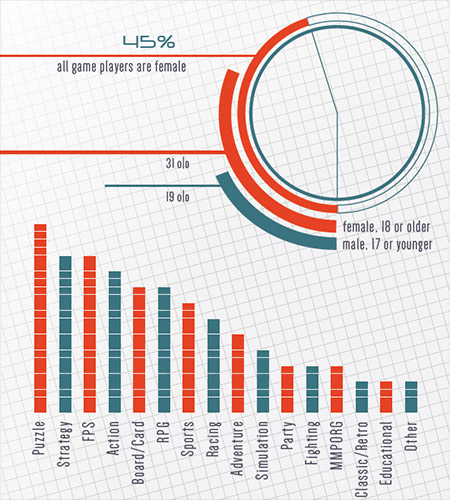Missunderstood gender representation in video games

As video games continue to dominate in sales, some heavy discussions are being held on the topic of gender representation in this medium. Derived from feminist film theories and long-standing criticisms of the male dominated pop culture, Anita Sarkeesian’s YouTube channel “Feminist Frequency” has opened the floodgates for praise as well as extreme opposition.
In her series, she spoke on the relationship video games have had with their female audiences since coming to consumer households in the 1970’s. Sarkeesian is just one of the many women out there who are working to bring this issue to the faces of developers and players alike, but despite this, competitive World of Warcraft gamer Acacia Brovedani said that there is sexism under the radar that is not being addressed.
“I have a lot of male geek friends who would 100 per cent support [Sarkeesian], and will happily post articles decrying male nerd entitlement culture and over sexualization of women in video games and yet, they’ll still express surprise that I’m ‘actually’ in to comic books, because I’m a conventionally attractive girl. Things like ‘You should play Diablo with us, but you should know we play hardcore.’ Or’’Really, *you* played WoW?’”
World of Warcraft is a MMORPG (Massively Multiplayer Online Role Playing Game) meaning that there are millions of players on a variety of servers that are accomplishing tasks all at the same time. When working together, some players will develop roles in their teams (guilds) that range from healers to attackers.
“There were also gender expectations about the roles – girls were almost always expected to be healers or ranged attackers. Tanks (Brutish players) were almost always guys – I’m not sure why that is. There was definitely an attitude that girls couldn’t be good tanks, whereas healer was their natural role – it’s funny how the ‘women as caretakers’ stereotype carries over to a complete fantasy world.”
Despite this, people like Brovedani see no reason to avoid video games as the level of sexism really doesn’t exceed other forms of media and women, like all those who enjoy games, are drawn in by the same qualities that make interactive experiences fun for people. This form of media is still experiencing changes and we’re hopefully going to see these changes applied in the future.
“I think there’s definitely progress being made, though it’s slow and intermittent. Games are adding female playables. There’s a wider array of sexuality being displayed. I think it’s going to be a long while before games have female protagonists that are allowed to be unattractive the same way male heroes sometimes are, but I have noticed a move away from evil women whose main personality trait is sexy,” Brovedani said.
In the broader sense, video games are reaching broad audiences and with that, we have a responsibility to be listening to people who are affected by the oppressive side effects of our cultural norms. Namely, we should be looking at the wider picture of games but we should ideally be sure to be aware of how our actions on a local level can still cause the same effects no matter what ideology we choose to identify as.
“Overt sexism from assholes is easy to filter out and ignore. Even stupid stereotypes and sexism built into video games is something I can roll my eyes at and play past,” said Brovedani. “But that insidious, casual sexism is often coming from friends, or men who consider themselves feminists, and it’s a lot harder to fight against. Yes I’m girly. Yes I’m a geek. Can we please stop being surprised by this already?”













